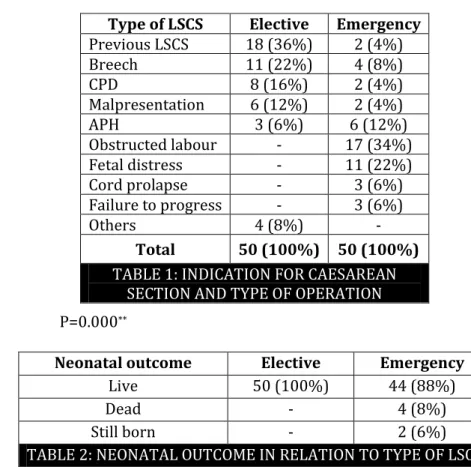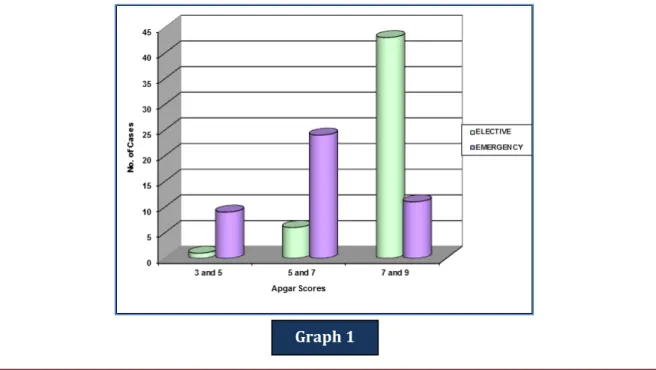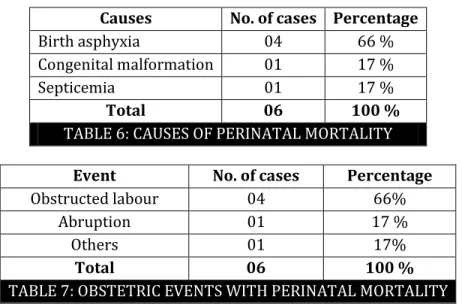J of Evolution of Med and Dent Sci/ eISSN- 2278-4802, pISSN- 2278-4748/ Vol. 3/ Issue 64/Nov 24, 2014 Page 13993
COMPARATIVE STUDY OF NEONATAL OUTCOME IN CEASAREAN SECTION
DONE IN REFERRED CASES VS ELECTIVE CEASAREAN DELIVERY IN A
RURAL MEDICAL COLLEGE HOSPITAL
Sowmya M1, Indranil Dutta2
HOW TO CITE THIS ARTICLE:
Sowmya M, Indranil Dutta. Comparative Study of Neonatal outcome in Ceasarean section done in referred cases vs Elective Ceasarean delivery in a rural medical college hospital . Journal of Evolution of Medical and Dental Sciences 2014; Vol. 3, Issue 64, November 24; Page: 13993-13998, DOI: 10.14260/jemds/2014/3872
ABSTRACT: OBJECTIVES: To study the fetal outcome of rural referrals undergoing emergency caesarean delivery versus elective caesarean delivery in a tertiary care hospital METHODOLOGY: This comparative study was done at a rural medical college hospital, Karnataka, from October 2010 to October 2011. 50 patients referred to the hospital and who underwent caesarean delivery are emergency group and 50 patients admitted in our hospital who were posted for elective cesarean delivery were the other group in the study with emphasis on indications and perinatal outcome.
RESULTS: obstructed labour (34 %) was the commonest indication in emergency and previous caesarean delivery (36%) being the commonest in elective group. The live birth was 88% in Emergency group as against 100% live births in Elective group. Perinatal mortality from emergency Caesarean sections accounted for 12%, with severe birth asphyxia responsible for most perinatal deaths. There was statistically significant difference in stillbirths, neonatal deaths, and severe neonatal morbidity between emergency and elective caesarean sections-probably related to prolonged labor, asphyxia, and sepsis than in elective caesarean delivery. CONCLUSION: The perinatal mortality was 12%, and the main cause of death was severe birth asphyxia. Emergency caesarean section was more likely than elective to result in a perinatal loss. The indication with the poorest fetal outcome was prolonged obstructed labor. Early diagnosis and timely intervention may result in decrease in incidence of morbidity and mortality. Emergency caesareans, when performed, are often too late to reduce perinatal deaths.
KEYWORDS: Emergency caesarean sections, Neonatal morbidity, Elective caesarean section.
INTRODUCTION: Parturition or giving birth is physiological; however it carries significant risk to well-being of mother and baby. Of all cases few are considered high risk and may require caesarean section in 10%. Good maternal and perinatal outcomes can be ensured through essential obstetric and newborn care provided by skilled attendants during pregnancy and childbirth.1,2 Complications during pregnancy and child birth are known to be closely associated with high stillbirth and perinatal mortality rate.3 Obstetric practice has witnessed an increasing frequency in caesarean deliveries.4
Caesarean delivery is a marker for the availability and use of obstetric services in this situations.5 Although usually lifesaving, caesarean delivery increases maternal and new born risks.6
Perinatal mortality and stillbirth rates are important indicators of the quality of antenatal and obstetric care in a community.7 The present study was to compare the indications, neonatal outcomes in selected emergency and elective caesarean section, and the association of caesarean delivery with perinatal morbidity and mortality.
J of Evolution of Med and Dent Sci/ eISSN- 2278-4802, pISSN- 2278-4748/ Vol. 3/ Issue 64/Nov 24, 2014 Page 13994
INCLUSION CRITERIA: Gestational age > 37 weeks, either booked or unbooked cases, Cases handled outside and referred, who underwent caesarean delivery on emergency and Cases admitted in our hospital for elective caesarean delivery.
EXCLUSION CRITERIA: Gestational age < 37 weeks, Multiple gestation, Medical and surgical disorders associated with pregnancy.
Information was collected in structured format and included relevant obstetric data, indications for caesarean section and intrapartum complications. Neonatal outcome and morbidity variables including 5 minute APGAR score <7, sepsis, asphyxia, need for Neonatal Intensive Care Unit admission were noted.
Differences in the outcome, frequencies between the two groups were analyzed using mean, rate and P values of less than 0.05 were accepted as statistically significant.
RESULTS: Majority of the patients in the referred group undergoing emergency caesarean, 84 % were in the age group of 18-25yrs, on the other hand in elective group 46 % of them were of 26-30yr. 74 % of patients were primipara in rural referrals of emergency group and 70 % of multipara in elective group. Most of the women in emergency caesarean section group were primigravida [74%] as compared to 30% in elective caesarean group. Obstructed labour and fetal distress was the most common indications for the caesarean section in the emergency group [34% and 22% respectively].
Neonatal outcome among the two groups is shown in Table 2. Two still born and two dead babies were present in emergency caesarean group. Neonates of emergency caesarean group had low Apgar scores of 3 and 5 (18 %) and 5 and 7 (48 %) at 1 and 5 min. 63 % of them required Neonatal Intensive Care Unit admission. Perinatal mortality in our study was 12%.
P=0.000**
Neonatal outcome Elective Emergency
Live 50 (100%) 44 (88%)
Dead - 4 (8%)
Still born - 2 (6%)
TABLE 2: NEONATAL OUTCOME IN RELATION TO TYPE OF LSCS
Type of LSCS Elective Emergency
Previous LSCS 18 (36%) 2 (4%)
Breech 11 (22%) 4 (8%)
CPD 8 (16%) 2 (4%)
Malpresentation 6 (12%) 2 (4%)
APH 3 (6%) 6 (12%)
Obstructed labour - 17 (34%)
Fetal distress - 11 (22%)
Cord prolapse - 3 (6%)
Failure to progress - 3 (6%)
Others 4 (8%) -
Total 50 (100%) 50 (100%)
J of Evolution of Med and Dent Sci/ eISSN- 2278-4802, pISSN- 2278-4748/ Vol. 3/ Issue 64/Nov 24, 2014 Page 13995 There were 44 (88%) live babies in Emergency group as against 50 (100%) live births in Elective group. There were % still births and 8% )ntra Uterine Death’s in Emergency caesarean group. There is statistically significant association between outcome and type of operation (P<0.05).
Apgar score at 1 and 5 min Elective Emergency
3 and 5 1 (2%) 9 (18%)
5 and 7 6 (12%) 24 (48%)
7 and 9 43 (86%) 11 (22%)
Total 50 (100%) 50 (100%)
Table 3: APGAR SCORES AT 1 AND 5 MIN IN BABIES DELIVERED BY ELECTIVE AND EMERGENCY SECTION
P=0. 000**
NICU Admission Elective Emergency
No 39 (78%) 17 (34%)
Yes 11 (22%) 29 (63%)
Total 50 (100%) 50 (100%)
TABLE 4: INCIDENCE OF NICU ADMISSION IN RELATION TO TYPE OF LSCS
NICU= Neonatal Intensive Care Unit, LSCS = Lower Segment Cesarean Section.
The Apgar score at 1 and 5 min was generally much lower in Emergency caesarean group. 18% of them had scores of 3 and 5, 48% of 5 and 7 and 22 % had 7 and 9 as compared to 2%, 12% and 86 % respectively in Elective caesarean group. The difference was statistically significant (P<0.05) and as also in terms of neonatal admission (P<0.05).
Graph 1: APGAR SCORES AT 1 AND 5 MIN IN BABIES DELIVERED BY ELECTIVE AND EMERGENCY SECTION
J of Evolution of Med and Dent Sci/ eISSN- 2278-4802, pISSN- 2278-4748/ Vol. 3/ Issue 64/Nov 24, 2014 Page 13996
NEONATAL MORBIDITY ELECTIVE EMERGENCY
Resuscitation with bag & mask 1 (2%) 9 (18%)
Birth asphyxia 0 6 (12%)
Meconium aspiration syndrome 1 (2%) 6 (12%)
Transient tachypnea of newborn 1 (2%) 2 (4%)
Hypoxic ischemic encephalopathy 0 3 (6%)
TABLE 5: NEONATAL MORBIDITY IN RELATION TO TYPE OF LSCS
There was statistically significant difference in need for resuscitation, asphyxia, hypoxic ischemic encephalopathy in emergency caesarean compared with elective caesarean sections.
Causes No. of cases Percentage
Birth asphyxia 04 66 %
Congenital malformation 01 17 %
Septicemia 01 17 %
Total 06 100 %
TABLE 6: CAUSES OF PERINATAL MORTALITY
Event No. of cases Percentage
Obstructed labour 04 66%
Abruption 01 17 %
Others 01 17%
Total 06 100 %
TABLE 7: OBSTETRIC EVENTS WITH PERINATAL MORTALITY
Early neonatal deaths and still birth rate were higher in emergency caesarean section group, obstructed labour being the most important cause.
DISCUSSION: During the study period, there were 4078 deliveries, with an overall caesarean delivery rate of 29.2%. Kambo et al reported an overall caesarean delivery rate of 24.2%. majority (42%) were primigravida, 31% were from rural areas, 20.8% of cases were referred, Dystocia (37.5%) and fetal distress (33.4%) %) were the major indications.4
Adikeri S et al reported a Caesarean rate of 63.27% and 55.48% among them were primigravida. Perinatal mortality rate was 12.5%. Among caesarean delivered babies 8.57 % of babies had poor Apgar score at 5 min8.The incidence of caesarean delivery in obstructed labour cases was 75.6% of which 38% of cases were referred from rural areas. Perinatal deaths were 21.7% 9. As reported by Al Nuiam et al statistically significant difference was found between emergency caesarean delivery and younger patients, low parity and low Apgar scores.10
When analyzed for Apgar scores in Emergency caesarean group, Apgar Score at 1 and 5 min was lesser (3 and 5, 5 and 7) as compared to elective caesarean group (7 and 9), as found in Gasparovic et al.11
J of Evolution of Med and Dent Sci/ eISSN- 2278-4802, pISSN- 2278-4748/ Vol. 3/ Issue 64/Nov 24, 2014 Page 13997 Onkappa B et al reported that caesarean section accounted for 11.1% of perinatal deaths. Emergency caesarean was more likely to result in perinatal loss than elective caesarean group. Prolonged obstructed labour was the indication, in cases of poorest fetal outcome.12 Ten neonates in our study developed early onset sepsis and were started on parenteral antibiotics. There was one neonatal death in emergency cesarean group due to hypoxic encephalopathy, as also found in Cebeku L study.13
Emergency cesarean delivery was associated with increased fresh stillbirths, neonatal deaths, and severe neonatal morbidity. Significant proportion of the perinatal deaths and severe newborn morbidity was related to birth asphyxia secondary to prolonged labor.14
The perinatal mortality rate in our study was 12 %, as compared to 21.7% and 11 % in other studies. Obstructed labour accounted for 6% of deaths as against 9.6% found in Rabindranath sahoo study.15 Presence of severe obstetric complication showed a close association with stillbirth, followed by low birth weight, caesarean section, and referral from a peripheral health facility. In addition, obstetric complications during the intrapartum period were independently associated with fresh stillbirths.16
Non-availability of Emergency Obstetrics Care, particularly caesarean section has been implicated as a risk factor for intrapartum stillbirth especially in cases of prolonged labour.17 While caesarean section can be a lifesaving interposition for mother and child, evidence showed that its use, particularly in low-resource settings could be associated with increased risk of perinatal mortality, especially when it is performed late.18
CONCLUSION: Emergency caesarean section is associated with significant perinatal morbidity and mortality. The rural units lack skilled manpower, equipment and other facilities to handle obstetric emergencies. Poor referral system, low socioeconomic status, illiteracy, and inadequate antenatal care, inadequate transport facilities to apex hospital-all this leads to increased risk of maternal and perinatal complications. Labour monitoring with partogram and early recognition and referral of high risk women, will reduce the incidence of emergency caesarean sections and thus decrease the incidences of maternal and perinatal morbidity and mortality.
REFERENCES:
1. World Health Organization. WHO Recommended Interventions for Improving Maternal and New born health. WHO/MPS/07.05. Geneva: WHO; 2007; 4.
2. World Health Organization. Managing Complications in Pregnancy and Childbirth. Geneva: World Health Organization; 2000; 79-81.
3. T. Kusiako, C. Ronsmans, and L. van der Paal, Perinatal mortality attributable to complications of childbirth in Matlab, Bangladesh. Bulletin of the World Health Organization, 2000; 78 (5); 621–627.
4. Kambo I, Bedi N, Dhillon B S, Saxena N C. A Critical Apprriasal of Cesarean section rates at teaching hospital in India. International Journal Gynecol and obstet 2002; 79: 151-158.
5. World Health Organization, UNFPA, UNICEF and AMDD. Monitoring Emergency Obstetric Care: a Handbook. Geneva: WHO; 2009; 6.
J of Evolution of Med and Dent Sci/ eISSN- 2278-4802, pISSN- 2278-4748/ Vol. 3/ Issue 64/Nov 24, 2014 Page 13998 7. Kambarami R. A. Levels and risk factors for mortality in infants with birth weights between
and , 8 grams in a developing country: a hospital based study, Central African Journal
of Medicine, 2002: 48(11-12);133–136.
8. Adhikari S, Dasgupta M, Sanghamita M. Management of obstructed labour: A retrospective study. J Obstet Gynecol India, 2005: 55(1); p: 48-51.
9. Sarkar CS, Paul SK. Obstructed labour-Astudy of 742cases. J Obstet Gynec of India. 1990; p: 648-652.
10.Nuiam L A, Soltan M H, Khashoggi T, Addar M, Chowdhury N, Adelusi B A. Outcome in elective and emergency caesarean sections: A comparative study. Annuals of Saudi medicine 1996; 16 (6): 645-649.
11.Gasparovic VE, Pulanic TK, Peter B. Maternal and fetal outcome in elective v/s emergency caesarean section in a developing country, College Anthropol; 30 (2006) 1: 113-118.
12.Onkapa B, Ekele B. Fetal outcome following caesarean section in a university teaching hospital. J of National Medical Association, 2009: 101(6); 578-581.
13.Cebeku L, Buchmann EJ. Complications associated with caesarean section in second stage of labor. Int J Obstet Gynecol; 2006: 95: 110-114.
14.Shah A, et al, Caesarean delivery outcomes from the WHO global survey on maternal and perinatal health in Africa, Int J Gynecol Obstet (2009).
15.Sahoo R, Chakladar BK. A Profile of maternity cases admitted in rural maternity and child welfare centres. J Obstet Gynecol India; 1992; 42 (1): 132-138.
16.Abdou Jammeh, Siri Vangen, and Johanne Sundby, Stillbirths in Rural (ospitals in The Gambia:
A Cross-Sectional Retrospective Study, Obstetrics and Gynecology International, vol. 2010, Article ID 186867, 8 pages, 2010.
17.S. E. Mooney, G. Ogrinc, and W. Steadman, )mproving emergency caesarean delivery response
times at a rural community hospital, Quality and Safety in Health Care, 2007; 16(1); 60–66.
18.X. De Muylder and J.-J. Amy, Caesarean section rates in an African country, Paediatric and Perinatal Epidemiology, 1993; 7(3); 234–244.
AUTHORS:
1. Sowmya M. 2. Indranil Dutta
PARTICULARS OF CONTRIBUTORS:
1. Consultant, Department of Obstetrics and Gynaecology, Sri Shivarathri Rajendra Hospital, Chamrajnagar, Karnataka, India. 2. Assistant Professor, Department of Obstetrics
and Gynaecology, IQ City Medical College, Durgapur, West Bengal.
NAME ADDRESS EMAIL ID OF THE CORRESPONDING AUTHOR:
Dr. Sowmya M, Consultant,
Sri Shivarathri Rajendra Hospital, Chamrajnagar, Karnataka, India. Email: sowmyam2006@gmail.com


